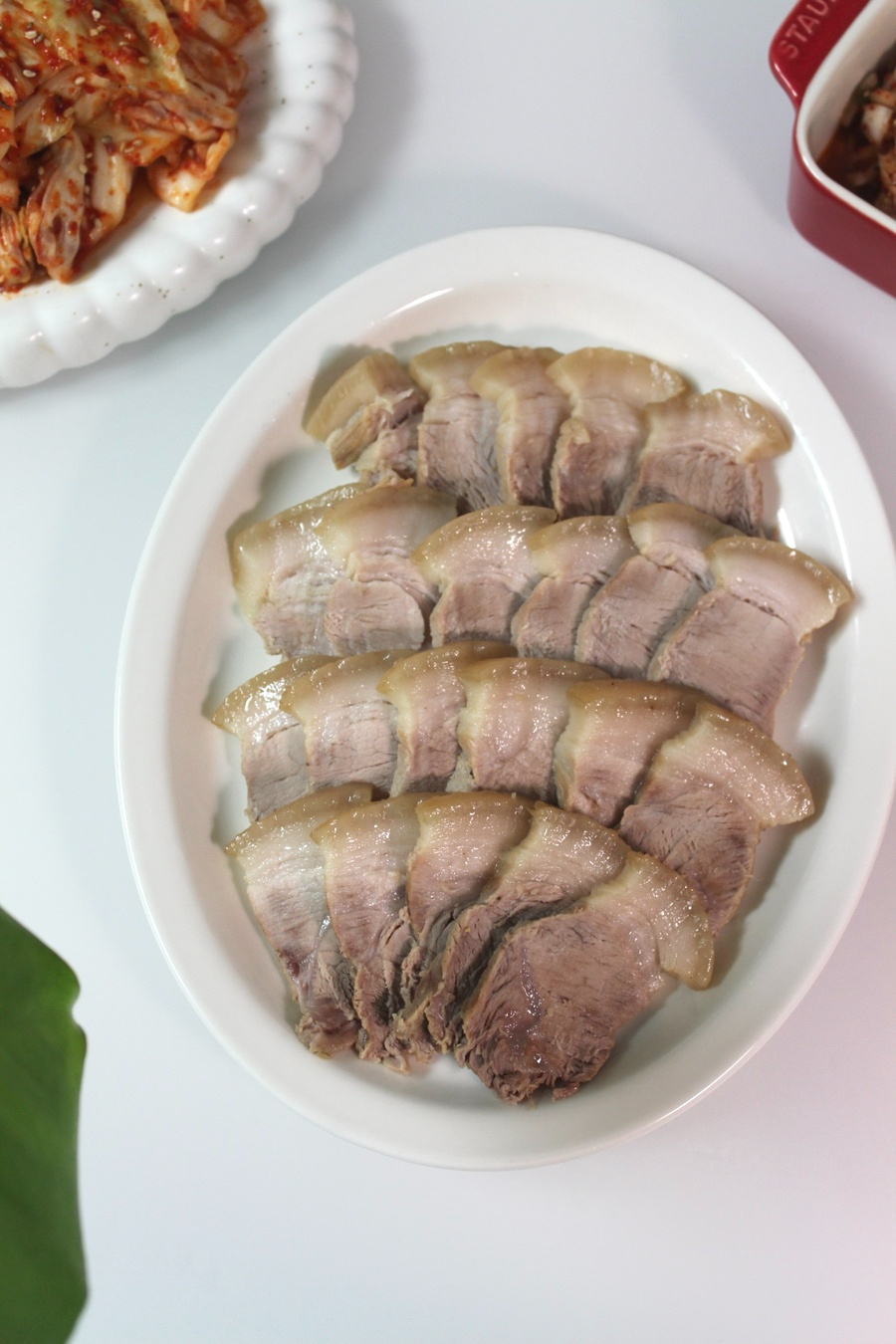Tender and Delicious Boiled Pork Leg
How to Boil Pork Leg for Deliciousness: Simple Recipe and Cooking Time

Enjoy delicious boiled pork anytime with this simple recipe! Today, we’ll show you how to make incredibly tasty boiled pork using pork leg, known for its balanced lean meat and chewy texture. Boiled pork, or ‘suyuk’, is wonderfully tender and flavorful when simmered with aromatic ingredients for the right amount of time. While pork belly or shoulder can also be used, I prefer pork leg with the rind on for its delightful chewiness. Even with a good amount of lean meat, proper heat control and timing ensure it remains tender. Although I often prepare ‘waterless’ boiled pork, today we’re opting for a straightforward method using water and aromatics. By adding doenjang (fermented soybean paste) and various herbs, we eliminate any gamey odor, and by carefully managing the heat from high to medium to low, we achieve a moist and delicious result. It pairs perfectly with kimchi or salted shrimp, and for those who prefer milder flavors, it’s also delightful with rice and ssamjang. I personally enjoyed it with a side of seasoned salted shrimp and cabbage kimchi, and we practically devoured a whole pound! Let’s get started on making the most delicious boiled pork.
Ingredients- Pork leg (with rind) 800g
- 1 stalk green onion
- 1 handful whole garlic cloves (about 10-12)
- 1/2 onion
- 1 Tbsp doenjang (fermented soybean paste)
- 15 peppercorns
- 2-3 bay leaves
- 3 Tbsp mirin (or rice wine)
- 1 liter water
Cooking Instructions
Step 1
First, prepare 800g of pork leg, our star ingredient. Using pork leg with the rind still attached (‘mibaek ap-darisal’) adds a wonderful chewy texture. Pat the surface of the meat thoroughly with paper towels to remove any excess blood. This step is crucial for a clean flavor without any gamey odors.

Step 2
Next, prepare the aromatics that will infuse the pork with flavor. You’ll need 1 stalk of green onion, 1/2 an onion, and a handful of whole garlic cloves. You can leave the garlic skins on or peel them, whichever you prefer.

Step 3
Now, get your pot ready. Place the pork leg, after patting it dry, at the bottom of the pot. Arrange the prepared green onion, onion, and garlic cloves attractively on top of the meat.

Step 4
Add 1 tablespoon of doenjang (fermented soybean paste). Doenjang is excellent for removing any gamey smell from the pork and also adds a subtle savory depth to the broth.

Step 5
Pour in 3 tablespoons of mirin (or rice wine). Mirin helps to tenderize the meat and further reduces any unwanted odors. If you don’t have mirin, you can use soju or even a neutral cooking wine. Finally, add 1 liter of water.

Step 6
Gently mix the ingredients in the pot to help dissolve the doenjang. Be careful not to break up the meat while stirring.

Step 7
Now, turn the heat to high and bring the water to a boil. Add 2-3 bay leaves to the pot for an extra layer of subtle fragrance. (If you forget, don’t worry, just add them later!)

Step 8
Once the water is at a rolling boil, keep the lid off and let it boil vigorously over high heat for 10 minutes. This initial stage helps to remove impurities and any initial gamey smells from the meat.

Step 9
After 10 minutes, cover the pot with a lid and reduce the heat to medium. Simmer for another 20 minutes. Cooking over medium heat allows the pork to cook through gently, ensuring it becomes tender on the inside.

Step 10
After the 20 minutes on medium heat, remove the lid, flip the piece of pork over, and reduce the heat to low. Continue to simmer for another 20 minutes. The total cooking time is about 50 minutes, with heat adjusted from high to medium to low. This gradual cooking process is key to achieving incredibly tender boiled pork.

Step 11
Once the 50 minutes of cooking are complete, turn off the heat. Leave the pork in the pot, covered, to rest for 5-10 minutes. This resting period, or ‘tem-dringi’ (steeping), allows the juices to redistribute throughout the meat, making it even more moist and tender.

Step 12
After resting, carefully remove the boiled pork from the pot and let it cool slightly. It’s best to let it cool a bit before slicing, as it can fall apart if cut while piping hot. Using a serrated knife, like a bread knife, is recommended as it cuts through the meat cleanly without compressing it.




